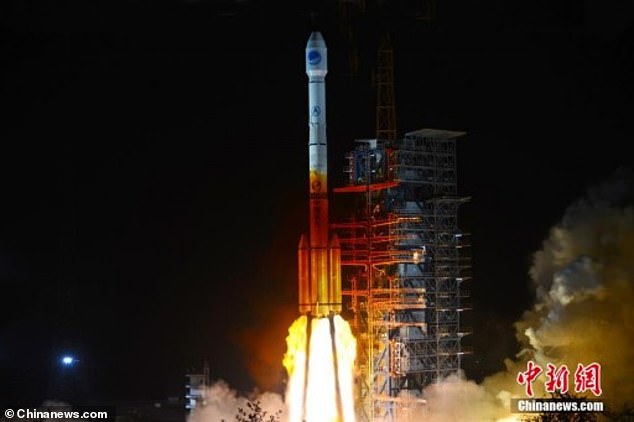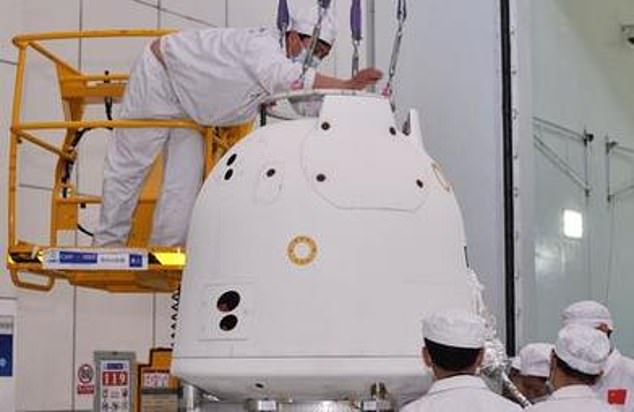Scientists reveal China’s rocket created ‘mysterious’ 100-foot-wide crater on the moon after it crashed last year – and the nation denied responsibility at the time
>
Scientists were able to solve the case of the “mysterious missile” that left a 100-foot-deep crater on the moon’s surface in March last year.
Researchers at the University of Arizona determined that the rocket was a rogue Long March 3C of the China National Space Administration It fell near the Hertzsprung crater on the far side of the Moon, which never directly faces Earth.
NASA spotted the new addition to the lunar surface in images taken by the Lunar Reconnaissance Orbiter (LRO), a robotic spacecraft currently orbiting the moon, and released in June 2022.
Experts previously speculated that a Chinese missile was responsible for the collision, although the country denied responsibility at the time.
The conclusion is based on the analysis of light reflections from the mysterious object, which were captured by the telescope before the collision.
Moon surface before impact (left) and after (right). Whatever formed the double crater probably had equal weight at both ends, scientists say

Researchers at the University of Arizona determined that it was a rogue Long March 3C rocket from the China National Space Administration, which struck near the Hertzsprung crater on the far side of the moon, which never faces Earth directly.
The telescope the scientists used did not have a high enough resolution to clearly capture the details of the flying object, but it captured the imprints of the light that reflected on it as it moved.
The researchers who conducted the study said that the body of the Long March 3C rocket collapsed before it collided with the moon.
China said earlier that part of it burned up when it returned to the Earth’s atmosphere.
So when NASA’s Lunar Reconnaissance Orbiter sent back images of a new crater, the truth was a bit murky.
The new results, published Thursday in The Planetary Science Journal, may clarify matters.
Based on the object’s rotation and trajectory, it was almost certain Long March 3C from China’s Chang’e 5 T1 mission in 2014, an instrument testbed for the 2020 Chang’e 5 mission to collect a lunar sample.
The case is not closed, though.
The adjacent craters indicate that the front end of the missile, the end opposite the engines, was much more heavily weighted than Chinese authorities revealed.
“Something has existed in space as long as it has been subject to forces from the gravity of the Earth, the Moon, and sunlight.” The study’s first author, Tanner Campbell, a doctoral student at the University of Arizona, said in A statement.

The China National Space Administration launched the Chang’e 5 T1 mission in 2014 to test equipment for a future lunar sampling mission.
‘Therefore, it is expected to wobble a little, especially when we take into account that the rocket body is a large empty shell with a heavy engine on one side.
“But this was just a tumble from start to finish, in a very stable way.”
If the reported missile payload was accurate, the missile would have swayed unevenly, like a boom with one end shorter than the other.
“We know the booster had a tooling deck mounted on its top end, but it only weighed about 60 pounds or so,” Campbell said.
“We performed a torque balance analysis, which showed that this amount of weight would have moved the rocket’s center of gravity by a few inches — not nearly enough to account for its stable rotation.”
“This leads us to believe that there must have been something more complex at the front.”
He and his colleagues suggest that the unprecedented double crater was likely formed when the object in question collided with the surface of the moon.
“This is the first time we’ve seen a double hole,” Campbell said.
“We know that in the case of Chang’e 5 T1, its impact was almost direct, and to get these two craters that are roughly the same size, you need two roughly equal masses that are far apart from each other.”
The impact of 2022 wasn’t a complete surprise, so there were several early suspects.
One was the upper stage of a SpaceX Falcon 9 rocket that launched from Cape Canaveral, Florida, in February 2015.
That rocket mission carried the Deep Space Climate Observatory (DSCOVR) satellite across the moon toward the sun.
In 2015, the rocket’s second stage traveled far enough to launch DSCOVR beyond the gravity of the Earth-Moon system, where the satellite will monitor solar storms.
The booster gave DSCOVR just the right boost but it exhausted its fuel before it could travel far enough to escape the gravity of the Earth and the Moon.
It then spent years in a precarious orbit around the Earth and the Moon.
Then, in January 2022, just two months before the double crater appeared, astronomer Bill Gray claimed on his blog Project Pluto — where he writes about near-Earth objects — that SpaceX instruments may have been about to collide with the moon.
Shortly after, NASA scientists said it was not a Falcon 9 booster, but a Long March 3C. Gray agreed and updated his blog.
(Tags for translation)dailymail
